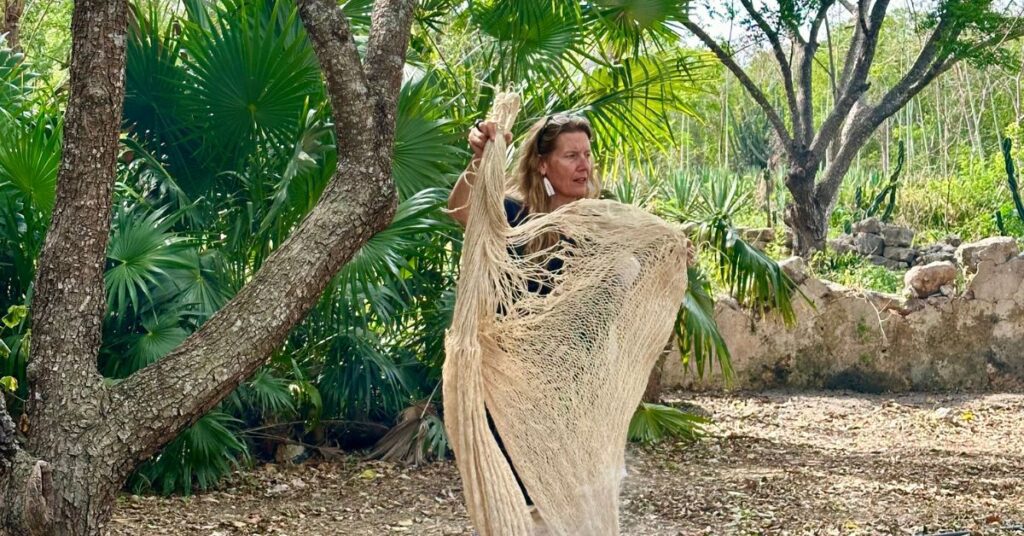When Angela Damman first arrived in Yucatán back in 2012 with her husband and partner Scott and two children, it was meant to be a six-month family adventure—an extended pause from her fast-paced life in international project development in the United States. But as many of us who fall in love with this region can attest, Yucatán has a way of shifting plans. That short stay turned into more than a decade of creative exploration, community collaboration, and a beautiful redefinition of sustainable luxury.
Angela didn’t come with a blueprint. What she brought instead was curiosity and an open heart. In our recent conversation, she recalled those early days: “I was inspired by everything—la tierra, the people, the colors, the sense of time. I wanted to learn, not impose. So I listened. I experimented. And little by little, things began to take shape.”
Rooted in the Land: The Beauty and Versatility of Henequén
Angela’s journey began with online research from her home in the U.S., sparked by a fascination with natural fibers and sustainable materials. She stumbled upon a listing for a remote hacienda for sale in Yucatán. Intrigued, they decided to find it—but with no Google Maps and only vague directions, the search became an adventure of its own. Eventually, they reached the overgrown property, surrounded by wild agave and steeped in history. They fell in love with its raw potential and decided to buy it.
At first, they camped out on the land, slowly learning its rhythms while building a home. All around them, henequén plants—once central to Yucatán’s fiber industry—grew untended, whispering stories of a forgotten craft. Angela’s curiosity deepened as she noticed everyday items in local villages, like the sabucán, a handwoven crossbody bag traditionally used by Maya men in the fields. She began asking questions, eventually tracking down a local woman who still wove using a backstrap loom.
With limited Spanish and a desire to learn, Angela immersed herself in the process—understanding not just the technique, but the cultural meaning behind each fiber and pattern. Those early days of exploration, connection, and mutual learning became the cornerstone of her work: design rooted in place, tradition, and respect for the land.
That sense of place became the foundation for Angela’s work. She became immersed in the textures and stories of the land—particularly the agave plants that had once powered Yucatán’s economy. Henequén, with its resilient, spiny leaves, had long been abandoned after the fall of the fiber industry. But Angela saw more than just history in it—she saw possibility.
While wandering the jungle of their property, Scott discovered a wild cluster of Agave sisalana, long thought to be nearly extinct in the region due to monoculture during the peak of the fiber trade. They began nurturing and transplanting these rare plants on their land, eventually cultivating a healthy, vibrant plantation that now supplies fiber with unique characteristics—an earthy green tone and distinct tensile properties that inform Angela’s designs.
“It’s such a dynamic material,” she explains. “Depending on how it’s processed—brushed, twisted, softened—it can shift from raw and rugged to delicate and architectural.”
Together, they’ve transformed their land into a living workshop and agave sanctuary, where Angela collaborates closely with Mayan women artisans, blending generational knowledge with design innovation. Her work is as much about reviving lost materials as it is about restoring connection—to the land, to culture, and to the rhythms of a more intentional life.
From Artisan Hands to Global Eyes: Signature Collections
Angela’s collections are elegant yet grounded—luxury that whispers rather than shouts. Her handwoven handbags, pendant lamps, and sculptural textiles have caught the eye of international designers and sustainability advocates alike.
One standout line is her Agave Collection, featuring fine accessories and objects crafted entirely from native fibers. Another is the Nido Collection, inspired by organic nest shapes, which explores the interplay of structure and softness through hand-coiled forms.
She’s also been part of significant design collaborations—among them a celebrated installation with architect Tatiana Bilbao at Design Miami, and features in Vogue, Architectural Digest, and exhibitions promoting sustainable luxury around the world.
Yet despite this global recognition, Angela keeps her roots local. “Everything I do is still based on that core idea—honoring where the material comes from, who is making it, and what story it tells.”
What’s Next? Innovation with Intention
The Maya Youth Artisan Initiative (MYAI) is Angela Damman and Assistant Professor, Ashley Kubley, University of Cincinnati College of Design, Architecture, Art and Planning. This grassroots program based in Hocaba, Yucatán, is designed to empower young Maya women by preserving traditional backstrap loom weaving with henequén fiber. Guided by elder artisans, participants learn ancestral techniques while also gaining modern skills in textile design, entrepreneurship, and financial literacy. MYAI blends cultural preservation with economic opportunity, offering a platform where heritage becomes a source of pride and livelihood. With growing support and demand for handmade, fair-trade goods, the program is building momentum—transforming a centuries-old tradition into a vibrant path toward self-sufficiency and creative leadership.
Read more about it here: @maya_youth_artisan_initiative
Angela continues to push boundaries—experimenting with new plant-based materials, exploring architectural applications, and mentoring younger designers interested in ethical production. Her next project? A deeper dive into regenerative practices that not only preserve traditions but also heal the land they come from.
At her workshop in the Yucatán countryside, where the rhythmic clack of weaving looms blends with birdsong, innovation is quiet but constant. “It’s not just about beautiful things,” she says. “It’s about beautiful relationships—with nature, with people, with time.”
You can follow her work at @angelammanyucatan and https://angeladamman.com




